2015 PEUGEOT 4008 lock
[x] Cancel search: lockPage 95 of 389

93
4008_en_Chap03_confort_ed01-2014
Front armrest
Pull the right-hand lever to open the storage
compartment lid, which serves as an armrest.
to c
lose, fold down the lid until it locks. Pull the left-hand lever to open the lid.to c
lose, fold down the lid until it locks.
th
is storage compartment may contain up to
3
accessory sockets.
th
is operates when the ignition switch is in the
"LOCK", "ACC" or "ON" position.
Open the cover of the front armrest to gain
access to the socket.
Upper storage compartment Lower storage compartment
Check that the electrical equipment
operates on 12 V and that its maximum
electrical power is 120 W.
th
e prolonged use of electrical
equipment without running the engine
may discharge the battery.
12 V socket
(120 W max)
3
Comfort
Page 100 of 389

98
4008_en_Chap04_conduite_ed01-2014
Starting - stopping the engine with the key
- Position 1: LOCK the steering is locked.
-
P
osition 2: ACC
t
h
e accessories (radio, 12 V socket...) can
be used.
-
P
osition 3: ON
I
gnition on.
-
P
osition 4: S TA R T
S
tarting the engine.
Ignition switch
If you use the accessories for a
prolonged period (with the key in
position 2 (ACC) ), you risk discharging
the battery. Starting your vehicle will
then no longer be possible. Be aware .
See the "Automatic power cut-off to
accessories" section.
Key in ignition
A buzzer sounds on opening the
driver's door, if the key has been left in
the ignition.
F
I
nsert the key in the ignition switch.
F
t
u
rn the key to position 2 (ACC)
and
unlock
the steering column, by turning
wheel slightly.
F
P
ress and hold the brake pedal.
F
F
ully depress the clutch pedal (vehicles
fitted with a manual gearbox).
F
P
ut the gear lever into neutral (vehicles
fitted with a manual gearbox), or in
position
P (vehicles fitted with a CV
t
gearbox).
F
O
perate the starter by turning the key to
position 4 (S TA R T ) .
F
O
nce the engine is running, release the key.
t
h
e key returns automatically to
position
3
(ON)
.
Starting using the key Stopping
F Immobilise the vehicle.
F
P ut the gear lever into neutral (vehicles
fitted with a manual gearbox), or in
position
P (vehicles fitted with a CV
t
gearbox).
F
W
hile pressing the key, turn it to position 1
(LOCK) .
F
R
emove the key from the ignition switch.
F
L
ock the steering.Do not attach any heavy objects to the
key as this could weigh down on it when
in the ignition switch and cause a fault.
For Diesel vehicles, when the engine
is cold wait with the ignition switch
in position 3 (ON) until the preheater
warning lamp goes off, before turning
the key to position 4 (S TA R T ) .
th
e warning lamp does not come on
when the engine is hot. Switching off the engine leads to a loss
of braking assistance.
Driving
Page 102 of 389
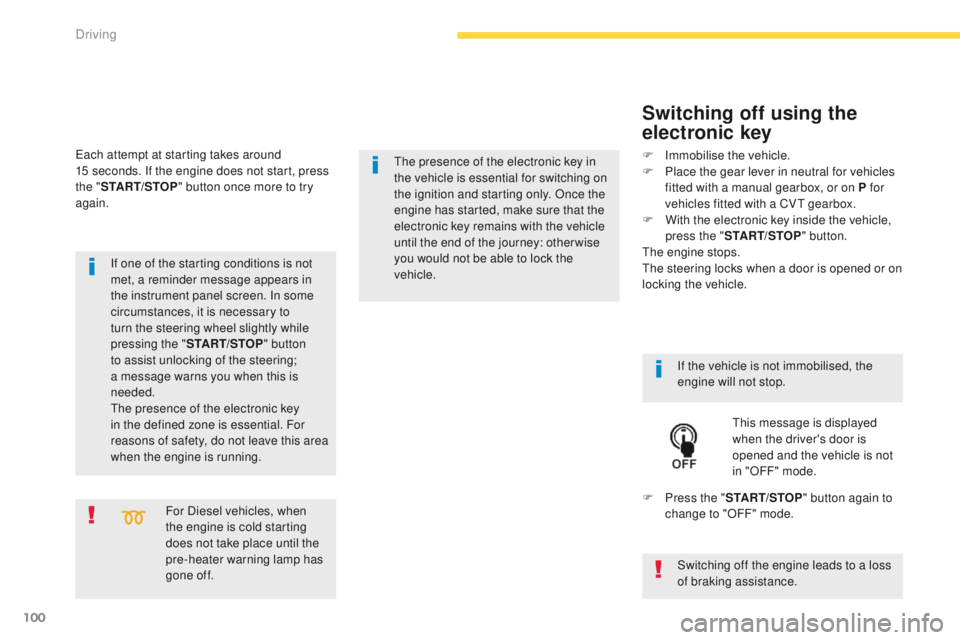
100
4008_en_Chap04_conduite_ed01-2014
For Diesel vehicles, when
the engine is cold starting
does not take place until the
pre-heater warning lamp has
gone of f.
If one of the starting conditions is not
met, a reminder message appears in
the instrument panel screen. In some
circumstances, it is necessary to
turn the steering wheel slightly while
pressing the "
START/STOP " button
to assist unlocking of the steering;
a message warns you when this is
needed.
th
e presence of the electronic key
in the defined zone is essential. For
reasons of safety, do not leave this area
when the engine is running.
Switching off using the
electronic key
If the vehicle is not immobilised, the
engine will not stop.
th
is message is displayed
when the driver's door is
opened and the vehicle is not
in "OFF" mode.
F
P
ress the " START/STOP " button again to
change to "OFF" mode.
F
Imm
obilise the vehicle.
F
P
lace the gear lever in neutral for vehicles
fitted with a manual gearbox, or on P for
vehicles fitted with a CV
t
gearbox.
F
W
ith the electronic key inside the vehicle,
press the " START/STOP " button.
the
engine stops.
th
e steering locks when a door is opened or on
locking the vehicle.
ea
ch attempt at starting takes around
15 seconds. If the engine does not start, press
the " START/STOP " button once more to try
again.
the presence of the electronic key in
the vehicle is essential for switching on
the ignition and starting only. Once the
engine has started,
make sure that the
electronic key remains with the vehicle
until the end of the journey: otherwise
you would not be able to lock the
vehicle.
Switching off the engine leads to a loss
of braking assistance.
Driving
Page 104 of 389
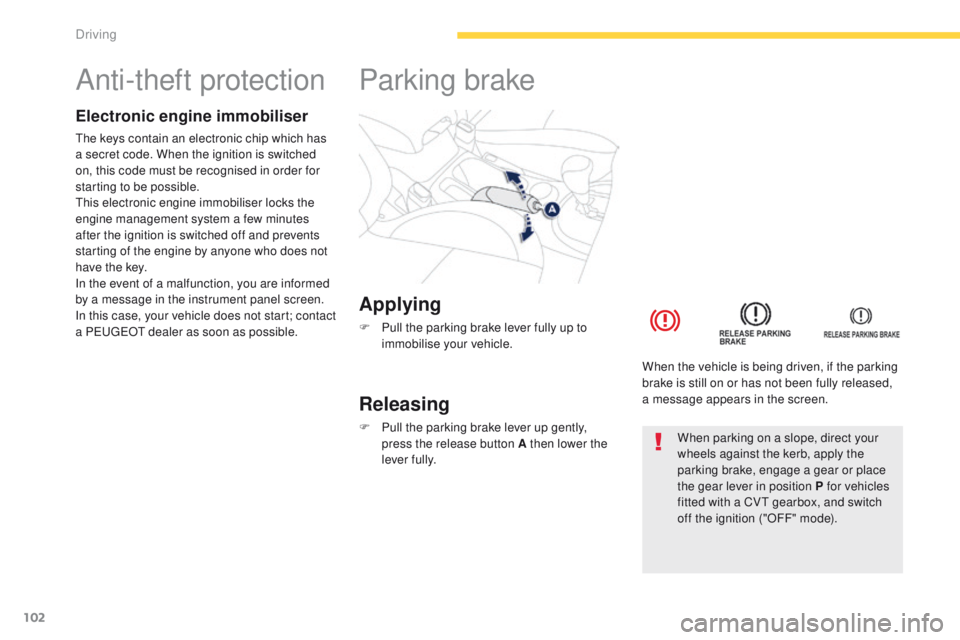
102
4008_en_Chap04_conduite_ed01-2014
Anti-theft protection
Electronic engine immobiliser
the keys contain an electronic chip which has
a secret code. When the ignition is switched
on, this code must be recognised in order for
starting to be possible.
th
is electronic engine immobiliser locks the
engine management system a few minutes
after the ignition is switched off and prevents
starting of the engine by anyone who does not
have the key.
In the event of a malfunction, you are informed
by a message in the instrument panel screen.
In this case, your vehicle does not start; contact
a P
e
uge
Ot
dealer as soon as possible.
Applying
F Pull the parking brake lever fully up to immobilise your vehicle.
Parking brake
Releasing
F Pull the parking brake lever up gently, press the release button A then lower the
lever fully. When the vehicle is being driven, if the parking
brake is still on or has not been fully released,
a message appears in the screen.When parking on a slope, direct your
wheels against the kerb, apply the
parking brake, engage a gear or place
the gear lever in position P for vehicles
fitted with a CV
t
gearbox, and switch
off the ignition ("OFF" mode).
Driving
Page 111 of 389
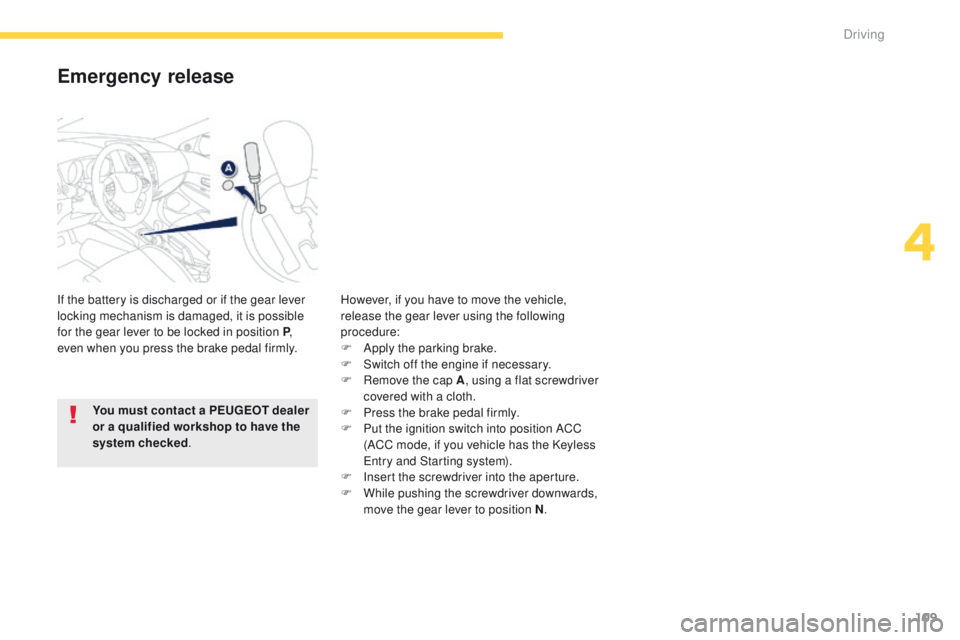
109
4008_en_Chap04_conduite_ed01-2014
Emergency release
If the battery is discharged or if the gear lever
locking mechanism is damaged, it is possible
for the gear lever to be locked in position P,
even when you press the brake pedal firmly. However, if you have to move the vehicle,
release the gear lever using the following
procedure:
F
A
pply the parking brake.
F
S
witch off the engine if necessary.
F
R
emove the cap A, using a flat screwdriver
covered with a cloth.
F
P
ress the brake pedal firmly.
F
P
ut the ignition switch into position ACC
(ACC mode, if you vehicle has the Keyless
en
try and Starting system).
F
I
nsert the screwdriver into the aperture.
F
W
hile pushing the screwdriver downwards,
move the gear lever to position N .
You must contact a PEUGEOT dealer
or a qualified workshop to have the
system checked
.
4
Driving
Page 120 of 389
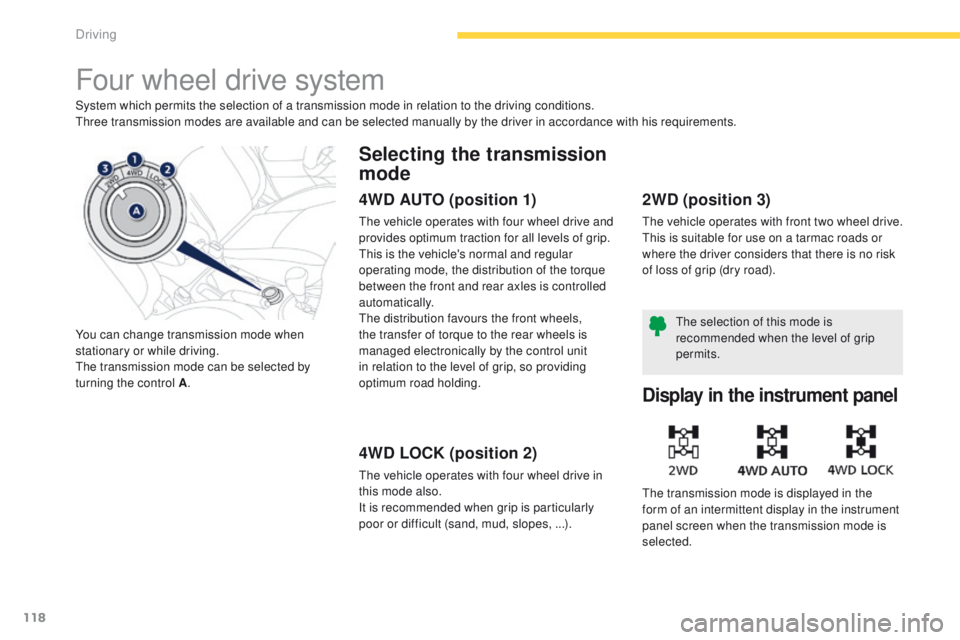
118
4008_en_Chap04_conduite_ed01-2014
Four wheel drive system
System which permits the selection of a transmission mode in relation to the driving conditions.three transmission modes are available and can be selected manually by the driver in accordance with his requirements.
You can change transmission mode when
stationary or while driving.
th
e transmission mode can be selected by
turning the control A .
Selecting the transmission
mode
4WD AUTO (position 1)
the vehicle operates with four wheel drive and
provides optimum traction for all levels of grip.
th
is is the vehicle's normal and regular
operating mode, the distribution of the torque
between the front and rear axles is controlled
automatically.
th
e distribution favours the front wheels,
the transfer of torque to the rear wheels is
managed electronically by the control unit
in relation to the level of grip, so providing
optimum road holding.
4WD LOCK (position 2)
the vehicle operates with four wheel drive in
this mode also.
It is recommended when grip is particularly
poor or difficult (sand, mud, slopes, ...).
2WD (position 3)
the vehicle operates with front two wheel drive.th is is suitable for use on a tarmac roads or
where the driver considers that there is no risk
of loss of grip (dry road).
Display in the instrument panel
the transmission mode is displayed in the
form of an intermittent display in the instrument
panel screen when the transmission mode is
selected.
th
e selection of this mode is
recommended when the level of grip
permits.
Driving
Page 121 of 389

119
4008_en_Chap04_conduite_ed01-2014
As the engine torque is applied to all
four wheels, the condition of the tyres
has a considerable impact on the
performance of the vehicle.
en
sure that all four tyres are in good
condition.
Avoid driving the vehicle in sandy or
muddy areas or in other areas in which
the wheels could spin.
Spinning the wheels places the
transmission components under
pressure and could cause a serious
malfunction.
Do not drive the vehicle through deep
water.
Avoid driving over excessively uneven
terrain (risk of scraping under the body
or of grounding on crossing a bridge).
Operating faults
If the selected transmission mode display
flashes, the vehicle switches automatically to
front "2WD" transmission mode.
It is then no longer possible to select the
transmission mode using the control A .
If the message "SLOW DOWN" is displayed on
the instrument panel, let the transmission cool
down then wait for the display to clear before
setting off again.
If "4WD" and "LOCK" are displayed alternately
and if "S
eR
VIC
e
R
eQuI
R
eD
" is displayed in
the instrument panel, the system has failed and
the safety system has been activated.
Contact a P
e
uge
Ot
dealer or a qualified
workshop without delay. Have your vehicle towed on a
flatbed.
th
e vehicle must not be towed with the
front or rear wheels on the ground even
if it is in front "2WD" (2 wheel drive)
mode.If the replacement of a tyre is
necessary on 4-wheel drive versions,
it is recommended that all four tyres be
replaced at the same time, ensuring
that the same make, model and size is
used on all wheels.
th
is is because using tyres of different
sizes, structure or rate of wear could
damage transmission components.
4
Driving
Page 132 of 389
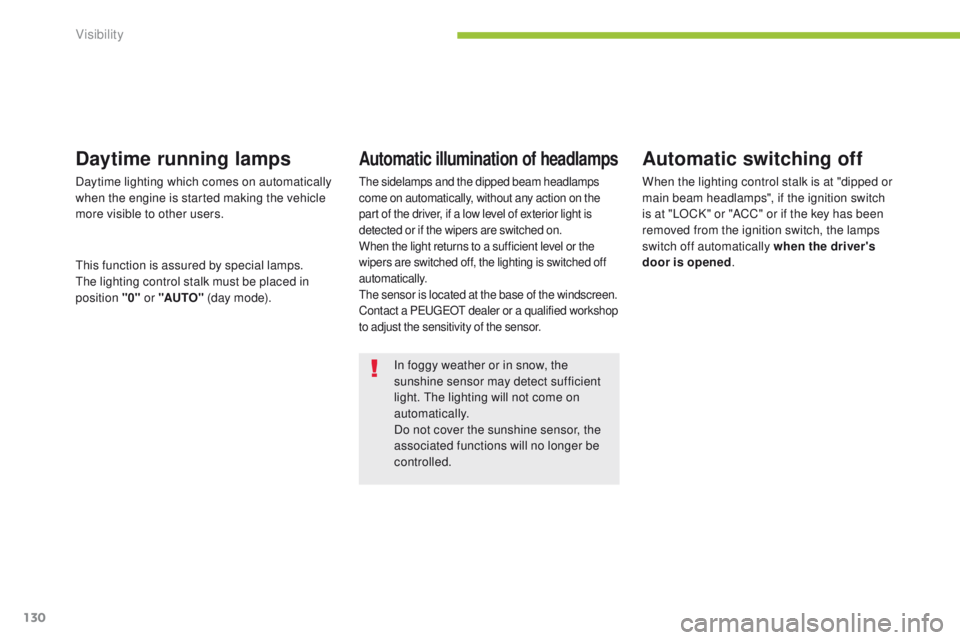
130
4008_en_Chap05_visibilite_ed01-2014
In foggy weather or in snow, the
sunshine sensor may detect sufficient
light. t
h
e lighting will not come on
automatically.
Do not cover the sunshine sensor, the
associated functions will no longer be
controlled.
Automatic switching off
When the lighting control stalk is at "dipped or
main beam headlamps", if the ignition switch
is at "LOCK" or "ACC" or if the key has been
removed from the ignition switch, the lamps
switch off automatically when the driver's
door is opened .
Daytime running lamps
Daytime lighting which comes on automatically
when the engine is started making the vehicle
more visible to other users.
th
is function is assured by special lamps.
th
e lighting control stalk must be placed in
position "0" or "AUTO" (d ay m o d e).
Automatic illumination of headlamps
the sidelamps and the dipped beam headlamps
come on automatically, without any action on the
part of the driver, if a low level of exterior light is
detected or if the wipers are switched on.
When the light returns to a sufficient level or the
wipers are switched off, the lighting is switched off
automatically.
th
e sensor is located at the base of the windscreen.
Contact a P
e
uge
Ot
dealer or a qualified workshop
to adjust the sensitivity of the sensor.
Visibility